Dental Services in Ocala
To achieve a healthy smile, Dr. Chandra utilizes the following technology for a successful result.
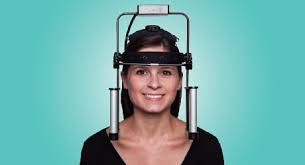
Chronic jaw clenching and grinding one’s teeth is called bruxism. While it can happen any time of day, it often occurs at night causing an individual to wake up with any number of symptoms including jaw pain, headaches, and sore teeth that may feel loose. Although, stress and anxiety are the most common causes of bruxism there may be other contributing factors such as a sleep disorder, an abnormal bite, as well as teeth that are missing or poorly aligned.
To alleviate the symptoms of bruxism, wearing a bite guard while sleeping is frequently recommended. This appliance is designed to fit over the teeth and to keep the jaws slightly apart. Wearing a bite guard prevents a number of damaging events including muscle strain, excessive pressure on the jaw joint (the TMJ), and such dental damage as chipped or cracked teeth resulting from the teeth grinding against each other.
In addition to preventing damage to the soft and hard tissues surrounding the orofacial cavity, a custom bite guard fabricated at the dental office can help curb a bruxism habit and give the wearer a better night’s sleep.
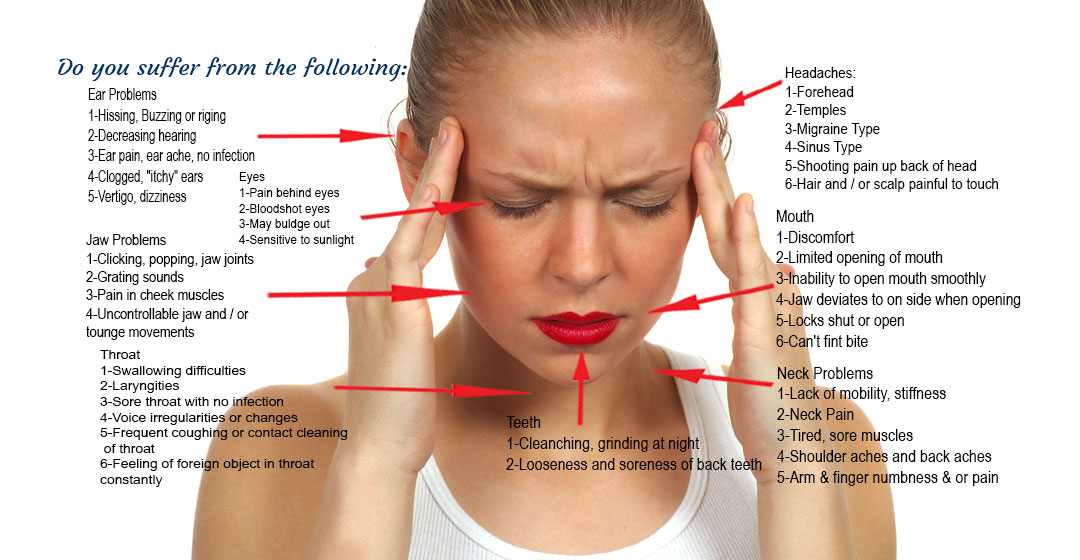
Chronic jaw clenching and grinding one’s teeth is called bruxism. While it can happen any time of day, it often occurs at night causing an individual to wake up with any number of symptoms including jaw pain, headaches, and sore teeth that may feel loose. Although, stress and anxiety are the most common causes of bruxism there may be other contributing factors such as a sleep disorder, an abnormal bite, as well as teeth that are missing or poorly aligned.
To alleviate the symptoms of bruxism, wearing a bite guard while sleeping is frequently recommended. This appliance is designed to fit over the teeth and to keep the jaws slightly apart. Wearing a bite guard prevents a number of damaging events including muscle strain, excessive pressure on the jaw joint (the TMJ), and such dental damage as chipped or cracked teeth resulting from the teeth grinding against each other.
In addition to preventing damage to the soft and hard tissues surrounding the orofacial cavity, a custom bite guard fabricated at the dental office can help curb a bruxism habit and give the wearer a better night’s sleep.

As part of the aging process wrinkles and furrows can develop between the brows and crow’s feet can appear around the eyes. These age-related imperfections can result in a tired and weary appearance. Fortunately, there is a non-invasive cosmetic procedure available today that can effectively address these unwanted signs of aging.
Botox is a prescription medicine that can be injected into the affected areas to dramatically improve the look of these fine lines and furrows. Made from a toxin produced by the bacterium Clostridium botulinum, Botox gives the skin a smoother, more refreshed appearance. It works by blocking nerve impulses and temporarily paralyzing the muscles that are causing these wrinkles and furrows.
Just a single short treatment with a few minor injections of Botox can produce a noticeable improvement that will last several months. Studies also suggest that Botox is effective in relieving migraine headaches, excessive sweating and muscle spasms in the neck and eyes.

When teeth are missing a series of changes that can impact your overall dental health and jaw function may be initiated. The adjacent teeth may start to drift or tilt into the space, and teeth in the opposing jaw may start to shift toward the area of the missing tooth. It is therefore important to replace the single tooth or multiple teeth that have been lost. One of the best options to prevent the consequences of shifting teeth and to restore full function to a small edentulous section in the mouth is a dental bridge.
A dental bridge replaces the missing teeth with artificial teeth called “pontics,” and is supported on the ends by prepared natural teeth. Once fabricated and fitted a dental bridge will be permanently “fixed,” or cemented into place. Like crowns, bridges can be made of either porcelain baked on to a metal substrate or many of the new ceramic materials that have been developed.
Cone-beam computed tomography systems are radiographic systems used by dental professionals to analyze and reconstruct 3D images of a patient’s teeth, jaws and surrounding anatomy. The information obtained by means of CBCT imaging is useful in both diagnosis and precise treatment planning when two-dimensional diagnostic films are insufficient. Dental CBCT is useful for multiple types of analyses as well as the assessment of maxillofacial disorders or pathology. It is also most useful in surgical planning, including the accurate placement of dental implants.
When the natural structure of a tooth has been extensively damaged or compromised due to dental decay, damaged fillings, root canals, or habitual clenching or grinding of the teeth, a dental filling may not be adequate for its repair. In such cases, dental crowns, also commonly referred to as caps, can be placed to effectively restore the natural integrity, function and appearance of the affected tooth.
Out of all of the materials that are available today for this type of full coverage restoration, metal-free crowns, also known as all ceramic crowns, offer most lifelike and biocompatible results. Strong and durable, ceramic crowns are lighter in weight than dental crowns that incorporate a metal substructure and are also kinder to the surrounding soft tissues. Furthermore, ceramic crowns present no problems for individuals with sensitivities to various metals. Since they are fabricated of the highest grade of dental ceramics, ceramic crowns most closely approximate the natural translucency of your own teeth.
Custom modeled for the optimal health and aesthetic of a patient’s smile, ceramic crowns can also be indicated for an array of dental treatments, ranging from the cosmetic restoration of discolored teeth, to the coverage of a structurally damaged tooth, dental implant, or as the supporting ends of a dental bridge.
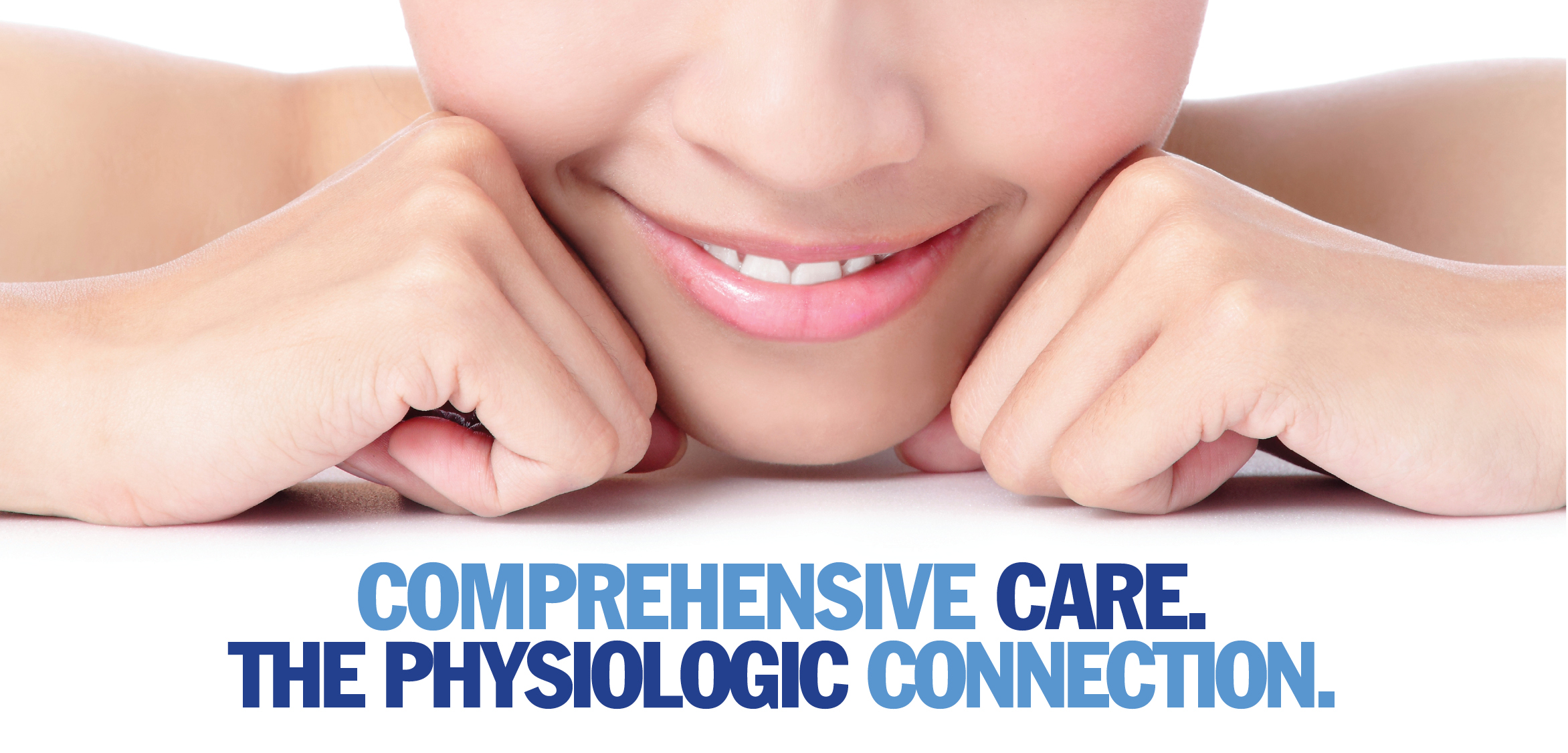
Your first visit to our office is very important with regard to establishing your oral health baseline. We will begin by carefully reviewing your medical and dental histories and taking special note of all of your dental concerns, as well as any symptoms that you may be experiencing. This will be followed by a thorough clinical examination, including an oral cancer screening, periodontal evaluation, an analysis of your occlusion (bite) plus a thorough examination of your teeth, their supporting structures, and the complete orofacial area. Any needed diagnostic dental films will be taken at this time.
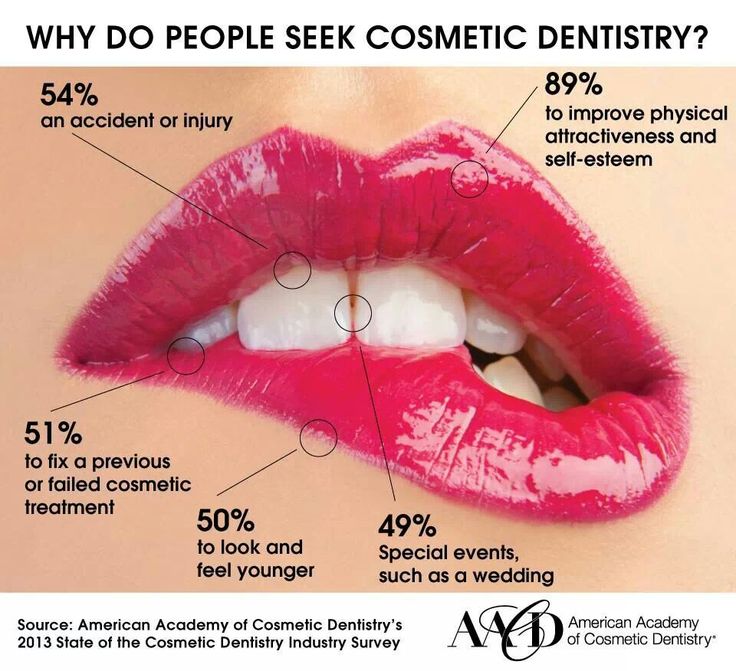
Thanks to advances in modern dentistry, teeth that have been affected by a range of imperfections or that have sustained damage from trauma or dental decay, can be restored to produce a naturally beautiful looking and functional smile. The cosmetic dental solutions available today can effectively improve and enhance the appearance of teeth that are stained, discolored, misshapen, chipped, fractured, gapped, crowded or broken down as the result of dental decay.
Cosmetic dental procedures can range from treatments that are relatively quick and non-invasive to more comprehensive plans of care to restore incomplete smiles that have been affected by severely damaged, lost, or missing teeth.

The terms dental crowns and caps are synonymous. If dental decay, cracked fillings, root canals, clenching or grinding the teeth have caused extensive damage to the underlying tooth structure a dental filling may not be a sufficient restoration. The only way to completely restore the cosmetic appearance and function of this tooth is often full coverage with a dental crown. The good news is that a completed dental crown looks and feels like a natural tooth.
In addition to restoring a single natural tooth, crowns can be used in other situations including being the supporting ends of dental bridge, covering dental implants, or as coverage for a cracked tooth to prevent further breakdown. A crown may also be indicated when a discolored or stained tooth needs to be restored to its natural appearance. Crowns can be made of either porcelain baked onto a metal substrate, all-porcelain, or many of the new ceramic materials that have been developed.
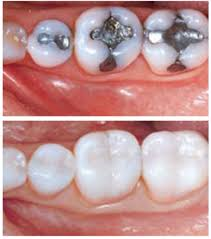
Dental Fillings are the most common type of dental restoration used to replace sections of teeth that are missing, damaged or decayed. While traditional dental materials like gold, porcelain, and composite successfully restore teeth; recent advances in dental technology have made a wider and improved selection of restorative choices available. Some of the newest state-of-the-art filling materials including ceramic and the latest composite materials, are not only strong and durable, they offer the most aesthetically pleasing and natural looking results.

Losing teeth can be devastating for dental health, and it is generally caused by other harrowing dental concerns. An uneven or incomplete bite can be even more damaging to a bite and a smile, which is why replacing lost teeth is so important. There are several solutions that can be considered when replacing lost teeth, and dental implant restorations are one of them. Dental implants are the closest thing to real teeth. Many people with implants claim that they feel and perform more like real teeth than other options like bridges or dentures. This is because dental implants are surgically attached to the jawbone, allowing patients to eat and speak with the same confidence they did with a completely natural smile.
Dental implant restorations do require some surgery, so not all interested patients may be eligible. An implant dentist can evaluate an individual’s dental health to determine whether they are capable of supporting implants and can begin prepping for the necessary procedure. Implants are set into place with titanium posts that act as artificial tooth roots. Once implanted, these posts actually meld with the bone during the healing process. This is known as osseointegration and it is what firmly secures the artificial tooth to the jawbone. Once the implant is set in place, the custom-made artificial teeth can be placed into the posts to create a seamless new smile.
The artificial tooth or dental crown placed into the anchored posts can be designed to match remaining teeth in order to look as natural as possible. Dental implants may require repair or general maintenance with time and use, just like real teeth, as they are subject to wear and tear over time – but overall, they will look and feel like real teeth. Dental implant restorations can be used to replace all teeth, many teeth, or a few teeth – it all depends on the patient’s needs.
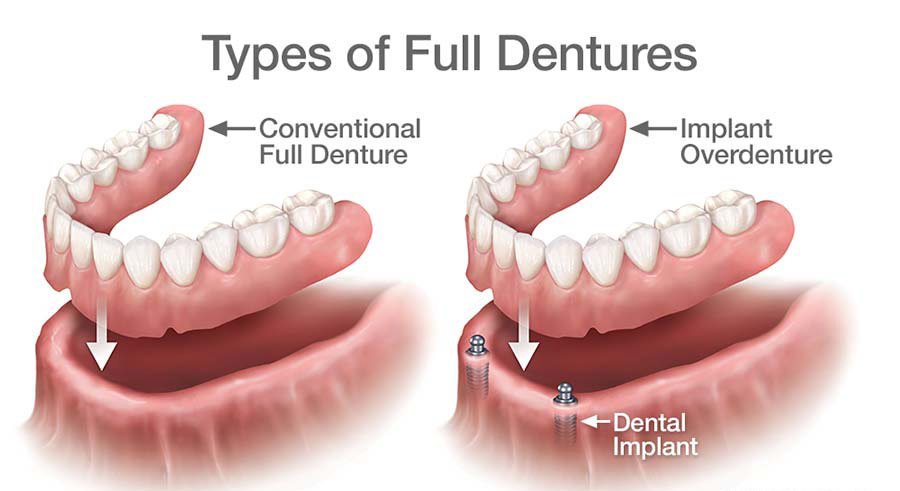
Whether from disease, malnutrition, genetic disorders, or an accident sometimes it is necessary for an individual to have some or all of their teeth extracted. While this can be devastating, partial or full dentures can be fabricated to restore an attractive smile, provide needed support for normal facial contours and reestablish a highly functional occlusion.
A denture consists of natural looking artificial teeth set in a supportive base. It may be fabricated to replace either a small group of teeth, an entire upper arch, an entire lower arch, or used to restore both dental arches.
A complete denture refers to the replacement all of the teeth in a dental arch. It can be inserted either of two ways. It can be inserted some weeks after the extraction sites and all of the surgical procedures have had a chance to heal, or as an “immediate” denture placed the same day the last remaining teeth are extracted. Although an immediate denture offers the advantage of not having to go without teeth for any period of time, it can require multiple adjustments as the tissues remodel and heal following dental extractions or other surgical procedures.
In situations where some sturdy teeth remain, partial dentures can be fabricated. Partial dentures can achieve adequate retention and stability by having clasps on the teeth surrounding the edentulous areas.
In some cases added stability for the dentures can be provided by strategically placed implants.

Digital radiography utilizes computer technology and digital sensors for the acquisition, viewing, storage, and sharing of radiographic images. It offers several advantages over the older traditional film based methods of taking x-rays. The most significant of these advantages is that digital radiography reduces a patient’s exposure to radiation. Other benefits are that images can be viewed instantly after being taken, can be seen simultaneously as needed by multiple practitioners, and can be easily shared with other offices. Digital x-rays are also safer for the environment as they do not require any chemicals or paper to develop.
An electronic pad, known as a sensor is used instead of film to acquire a digital image. After the image is taken, it goes directly into the patient’s file on the computer. Once it is stored on the computer, it can be easily viewed on a screen, shared, or printed out.
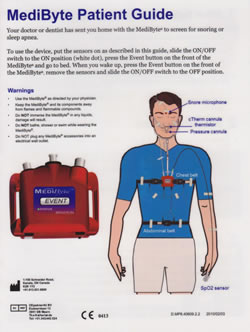
Medibyte is a screening tool to measure snoring or obstructive sleep apnea. A home sleep kit can be sent home with a patient to give information on sleep patterns, oxygen levels, heart rate, snoring, body position, and any events that may take place during the night. This information helps Dr. Chandra to be able to determine what type of device may be needed to help with sleep apnea.
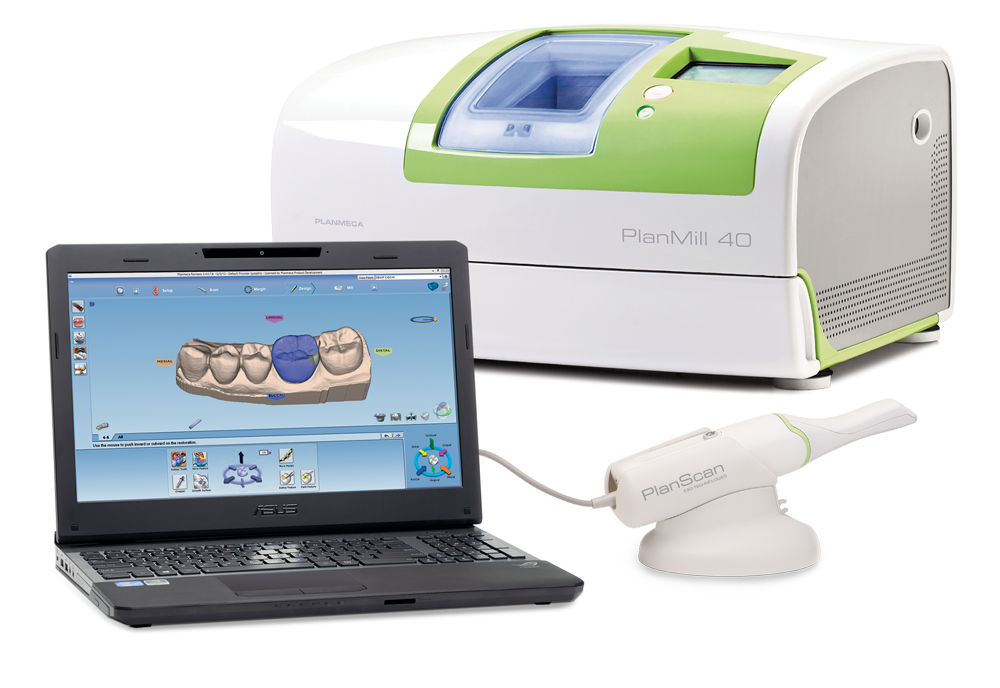
PlanScan® allows for the preparation and placement of a crown within two hours. The system eliminates the need for multiple visits, temporary crowns, and messy dental impressions.
PlanScan® is a high-tech process during which the tooth to be crowned is scanned, a restoration is digitally designed, and the permanent restoration is precisely milled right in the dental office.
The process utilizes a computer aided design and computer aided manufacturing. A PlanScan® single visit crown offers much more than a convenient approach to getting a dental crown. It is a highly attractive and extremely durable permanent dental restoration.

At the pinnacle of advanced healthcare technology, the PlanScan® CAD/CAM restorative systems and software solutions enable dental practices to provide their patients with “same day” in-office ceramic restorations. With PlanScan® technology your dentist can take digital impressions, create virtual models, and precisely mill the highest quality ceramic restorations all on the very same day. Using this advanced approach to care eliminates the need for messy impressions, the inconvenience of multiple dental appointments and the extra wait required with outside laboratory-fabricated restorations.
Losing a tooth due to injury, dental decay, or gum disease can happen. However, in order to avoid causing problems for the adjacent teeth and your overall dental health, it is important to replace the tooth that has been lost. This can be done a number of ways including fixed bridges, removable partial or full dentures as well as a more recent procedure known as dental implants.
One of the most significant dental innovations in recent times, an implant is a small surgical fixture made of biocompatible metal or ceramic materials that is placed into the jawbone and functions in the same manner as the root of a tooth. In the same way that natural root supports the natural crown of your tooth, an implant once it fully integrates with the surrounding bone, provides a stable and durable foundation for a replacement tooth. Implants often support a crown for an individual tooth, but can also be used as abutment teeth for a dental bridge, or strategically placed to help stabilize a denture.
Out of all of the restorative choices available today an implant comes the closest to replicating the look, feel and function of a natural tooth. Furthermore, it is the only method of tooth replacement that does not require the involvement or preparation of the adjacent teeth. A dental implant also stimulates bone remodeling to prevent shrinkage in areas where teeth are missing and helps to restore facial contours in areas where significant bone loss has occurred.
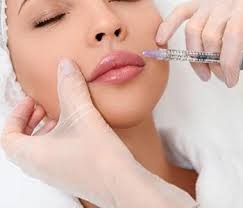
Young, healthy-looking skin contains an abundance of a naturally hydrating substance called hyaluronic acid (HA). However, as you age, sunlight and other factors can reduce the amount of HA in your skin. This lack of HA causes your skin to lose structure and volume, creating unwanted facial wrinkles and folds – like those parentheses lines around your nose and mouth. Using a dermal filler such as Juvederm® is a safe and effective way to replace the HA your skin has lost, bringing back its volume and smoothing away facial wrinkles and folds. It is a simple way to restore a more youthful and vibrant appearance.
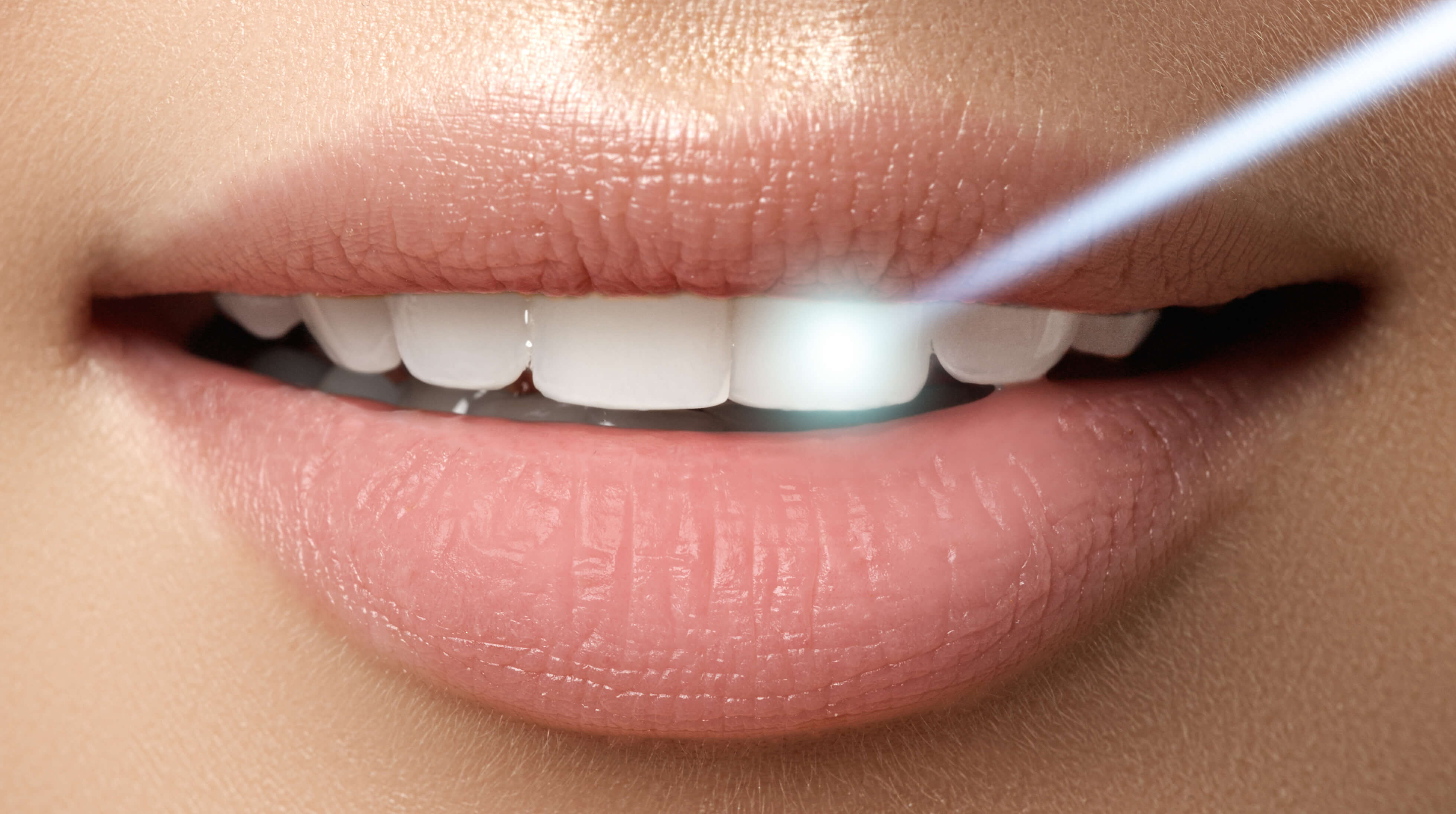
Fotona Lasers is a world-leading medical laser company. One of the significant advances in modern dentistry has been the development of dental laser technology. Today, dental lasers are being increasingly used to treat tooth decay, periodontal disease, perform biopsies or the removal of oral lesions, to cure restorative (filling) materials, as well as to activate in-office teeth whitening systems.
Dental lasers combine laser energy with water and air to safely cut and shape target soft or hard tissues in the mouth. Laser energy precisely cuts through tooth structure by exciting the water molecules in the tooth. It operates without direct contact to the tooth without heat, vibration, or pressure thereby minimizing the discomfort of the procedure and the need for dental anesthesia. In addition dental lasers can reduce anxiety for patients fearful of dental work, minimize post-operative bleeding and swelling, and preserve healthy tooth structure during the removal of decay.
While dental lasers may be an excellent treatment option in some situations, they cannot be used for every dental procedure.
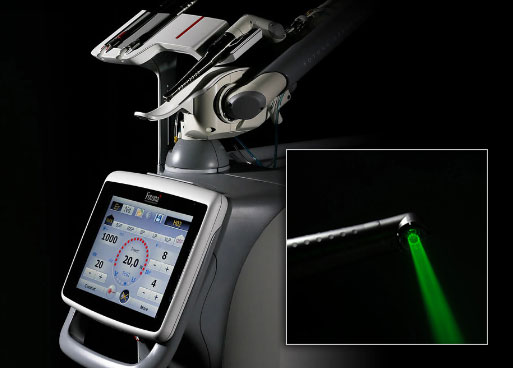
Fotona Lasers is a world-leading medical laser company recognized for its innovative, award-winning laser systems for applications in aesthetics & dermatology, dentistry, surgery and gynecology. Based in the US and EU, with corporate headquarters in Dallas, Texas and Ljubljana, Slovenia, Fotona’s business philosophy is to continuously choose perfection to meet the needs of a highly demanding marketplace.

When the structural integrity of a tooth has been compromised, be it from dental decay, cracks or fractures, restoring the damaged area with a filling serves to rebuild the tooth’s natural form and return it to full function.
Up until recent decades, most dental fillings have been composed of amalgam, which is a mixture of metals. While amalgam fillings are very effective and durable, newer materials offer the benefits of being both mercury and metal free as well as much more aesthetic. These “tooth-colored or white fillings” invisibly restore the form and function of the involved tooth, while seamlessly blending in with the remaining tooth structure as well as the individual’s overall smile.
Tooth colored fillings are made out of the latest generation of composite resin materials in which filler particles are bound together by a hard matrix material. Strong and durable, tooth colored fillings are chemically bonded to fill and rebuild a tooth once the decayed or damaged tooth structure has been removed. With a low potential for expanding and contracting at different temperatures, composite fillings are less likely than traditional amalgam fillings to damage the remaining tooth structure over time.
In addition to restoring teeth affected by injury or decay, composite resins can also be used to cosmetically change the size, color or shape of teeth with imperfections or minor alignment issues such as spacing.

Since the oral cavity is a gateway to your airway. Dr. Chandra helps to evaluate and screen for Sleep Apnea. The Gold Standard used to be a CPAP machine for treating snoring and sleep apnea. An alternative of treating sleep apnea is the Mandibular Advancement Device (MAD). It is an oral appliance that fits in the mouth that moves the lower jaw forward. A MAD appliance helps to diminish any restrictions that occurs in the back of the throat by moving the jaw and tongue forward away from the back of your throat, which opens up the upper airway, thus reducing the air resistance that leads to snoring. There are many reasons why people snore, many of which are connected to the partial obstruction of the airway to and from the lungs by the tongue or throat tissue.
A healthy, functional and attractive smile requires teeth that are straight and jaws that are well aligned. The goal of orthodontic treatment is to correct the cosmetic and functional problems associated with teeth that are either overcrowded, have spaces between them, or that have shifted over time due to extractions, habits, or abnormal bite patterns. Orthodontics can also address skeletal discrepancies between the upper and lower jaws.
Orthodontic treatment can range from the minor movement of a few teeth to the alignment of an entire bite. It may also be used in some cases to align teeth both before and after the surgical correction of severe jaw discrepancies.
Orthodontics utilizes the principles of physics to slowly move teeth into their proper positions. This is performed by using a selection of corrective appliances, including braces, clear aligners, and retainers. Designed to apply incremental and controlled forces to move the teeth in the desired direction, these appliances are adjusted on a regular basis throughout the course of care. Once a malocclusion is corrected and the teeth are completely aligned, retainers are often placed to help ensure that the result remains stable.
Orthodontic treatment time depends on the patient’s age, the severity of the malocclusion and the unique needs of each particular case. Some corrections can be accomplished in a few months while others can take a few years. However, for many malocclusions the average length of orthodontic treatment time is 24 months.
Periodontal disease damages the surrounding soft tissues and bone that support the teeth. It is predominantly caused by the accumulation of bacteria, mucus and other particles in the form of plaque or tartar that sit between the teeth and the gums. Periodontal disease can range in severity from a simple gum inflammation, known as gingivitis, to a more serious inflammation of the periodontal tissues. Left untreated periodontal disease can result in significant tissue damage and eventual tooth loss.
The problem with periodontal disease is that often the progression is painless. As a result the affected individual may not be aware of an ongoing disease process. This is why it is so important to recognize the signs of the earliest stage of periodontal disease, which is gingivitis. The symptoms of gingivitis typically include red, swollen and bleeding gums. Treatment instituted at this point is often sufficient to reverse the course of the disease and to avoid any permanent damage to the periodontal tissues. A series of deep dental cleanings, an improved home care regimen, and a commitment to regular maintenance may be all that is required to prevent this stage of periodontal disease from progressing.
Left untreated, gingivitis can escalate into periodontitis. However, there are other factors that can contribute to the escalation of periodontal disease, including smoking, genetic tendencies, and unchecked diabetes. In either case, when periodontal disease has progressed to a more advanced stage there is usually clinical and radiographic evidence of damage to the bone and soft tissues supporting the teeth. Periodontal treatment in this phase is designed to halt the progression of the disease and to restore tooth support as possible. This may involve medications to control the bacteria and reduce the size of the pockets between the teeth and gums, gum surgery, as well as bone and tissue grafts.
Physiologic dentistry is the art and science of using the relaxed position of the muscles of the head and neck to place the jaw into an optimal healthy physiologic bite position.
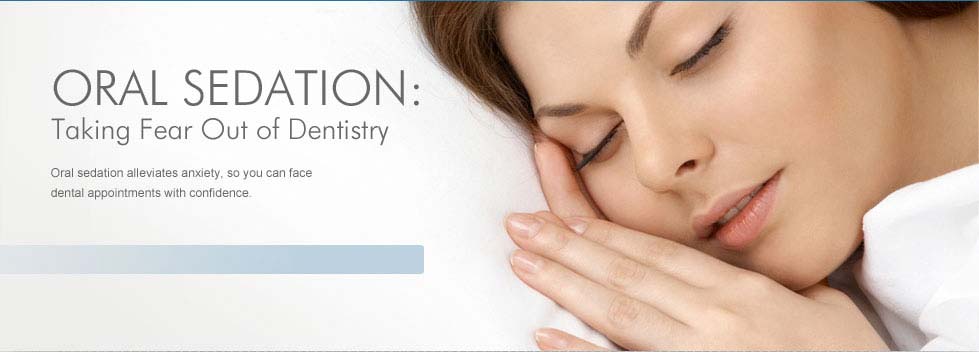
Sedation dentistry offers individuals with general anxiety about going to the dentist or fears about a specific dental procedure the opportunity to have a stress free and more comfortable experience. Utilizing safe and controlled sedation techniques prior to the dental procedure the patient is eased into a state of complete relaxation. This eliminates any discomfort, pain, and preoperative anxiety that may be associated with a particular dental visit. With sedation dentistry patients typically feel more at ease post-operatively as they have little or no memory of the actual moment-to-moment dental procedure.
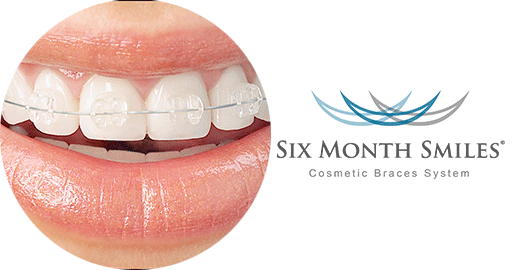
Six Month Smiles is a non-invasive treatment to improve an individual's visible smile. Unlike orthodontists, who change the patient's bite in it's entirety, Six Month Smiles is used to improve minor crookedness of a patient's teeth or spaces in-between which may make the individual uneasy or self-conscious about their smile. It is also a positive alternative to veneers, which is a more expensive option in which your teeth must be ground down and polished in order to place the veneers over the teeth.

Sleep Apnea is a sleep disorder characterized by pauses in breathing during sleep. Sleep impacts the body’s ability to fight off illnesses and is essential to physical and emotional well-being. In addition to annoying symptoms of daytime sleepiness, irritability and work difficulties, Sleep Apnea can lead to serious health risks like cardiac problems, stroke, high blood pressure, obesity, diabetes, impotence and even death. Don’t let poor sleep interrupt the quality of your life.
You may have a sleep disorder if you answer yes to any of these following questions:- Do you feel tired all the time?
- Do you awaken with a headache on a frequent basis?
- Have others complained that your snoring keeps them awake?
- Have you been told you gasp for air or stop breathing during sleep?
- Do you have trouble falling asleep?
- Do you experience involuntary movements that interrupt your sleep?
- Are you impatient, irritable, depressed or anxious?
The gold standard for treating Sleep Apnea has long been an oral appliance called a CPAP machine. Although very effective, some people are unable to tolerate the CPAP machine. In many cases, sleep apnea sufferers may benefit from a more comfortable jaw-aligning oral appliance. The purpose of the device is to reposition the tongue forward and out of the throat to allow for a clear airway. Delivering more oxygen to the body allows you to wake up feeling more rested and energetic. Call us today if you would like to hear more about how Dr. Chandra can help you with this treatment.
NightLase™ is a new approach to treating snoring issues.It utilizes laser technology that is non-invasive, with no appliances that need to be worn while sleeping. It is an effective way of reducing or eliminating snoring. NightLase™ is performed in as few as three short visits 21-28 days apart.
SmoothLase/LipLase can achieve younger looking skin and fuller, more youthful lips without surgery or injections. There is no recovery time. Your body’s own production of collagen is stimulated using laser technology. Helps to improve skin color and tone. In as few as 5-6 repetitions of Laser treatment, 21-28 days apart (SmoothLase™) or 3-4 repetitions of laser treatment, 21-28 days apart (LipLase™, Facial Rejuvenation), long lasting results are achieved. Lasers can remove skin tags, brown spots, certain moles, fibromas, treat rosacea, herpetic lesions and wipes out painful canker sores and much, much more..
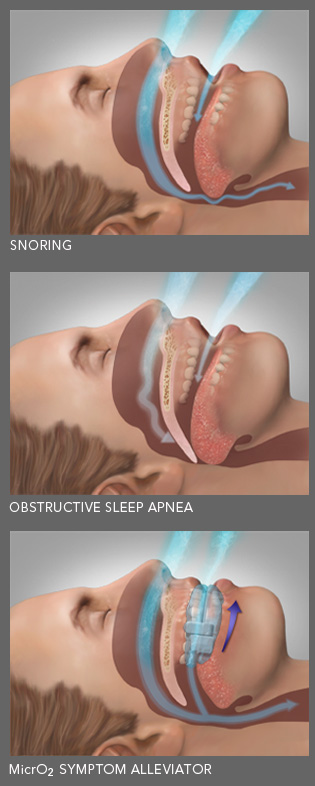
Getting a full night of sleep is essential to your overall health. Being well rested helps you to feel good and to function at your best. One of the most common problems that can affect the quality of your sleep is snoring. According to statistics about 90 million individuals in the United States snore while they sleep. While for about half of these people the problem is simply snoring, the others may be afflicted with a serious disorder known as sleep apnea. Therefore, before any type of treatment can be prescribed, it must be determined whether the problem is sleep apnea or “simple” snoring.
If it is determined that your problem is simply snoring, and you are what is known as a primary snorer, then an oral appliance can help you as well as any of your roommates enjoy a quieter and more comfortable sleep. A custom fabricated oral appliance to address snoring fits somewhat like a sports mouthguard or orthodontic retainer and is only worn while you sleep. As a removable and non-invasive treatment for snoring, your appliance slightly repositions your jaw to allow for a less restricted airflow to promote a quieter and more restful sleep.

Teeth that have been stained or darkened by food, tobacco use, age, medications or injury can be lightened and brightened by means of a non-invasive process known as teeth whitening.
Teeth whitening or bleaching simply refers to any process that will make the teeth appear whiter. While there are many over the counter options for teeth whitening, the most effective and safest teeth whitening systems are the professional strength ones available at the dentist’s office. A dental professional whitening system offers a higher concentration of whitening components and delivers them to the teeth in the most efficient manner to achieve optimal results.
At our office we offer two exceptional options for tooth whitening. You can choose either an in-office tooth whitening procedure or a professional take home system. Both of these are top-of the-line Zoom systems. However, the biggest advantage of the in-office procedure is that in as little as one hour you can achieve a smile that is several shades whiter and brighter than the original color of your teeth.
Our professional strength take home system also produces excellent results. However, this is achieved by way of a more gradual process. Our take home kit may be prescribed alone, or after an in-office treatment to perfect or maintain the in-office result.
If you are interested in Zoom Whitening, you'll be glad to know that we offer this service to you. Call us today for a complimentary Zoom consult and see if we can brighten your day!
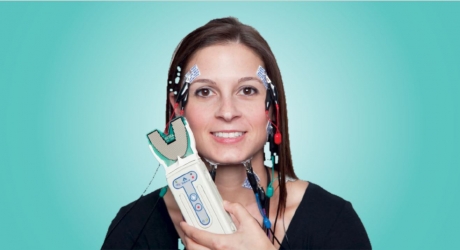
It is important to have a healthy bite, or the way the top teeth fit with the bottom teeth harmoniously. A bite equilibrator, otherwise known as the T-Scan®, dentistry’s only clinically recognized and research validated digital occlusion analysis system. It points out pressure point on an uneven bite. T-Scan® provides dynamic occlusal measurement—revealing the level and timing of force on individual teeth and the occlusal stability of the overall bite. With T-Scan®, Dr. Chandra can visualize and treat destructive forces before they become a problem, yielding better patient outcomes. T-Scan® helps Dr. Chandra educate patients. It also aids with diagnosis and planning a good healthy bite. This reduces the events of painful, unnecessary teeth breakages or repeated visits to the Dentist.

Among the most common, irritating and difficult to diagnose problems with head and neck pain are temporal mandibular joint problems, more commonly known as TMJ problems. The joint is located near the ear where the top of the mandible or lower jaw meets the upper jaw at the base of the skull.
Like all other joints in the body, the TMJ is subject to inflammation and other chronic joint problems. Many of these issues may be caused by destructive bite habits like clenching or grinding. These actions cause pressure on the joint that can lead to inflammation and general breakdown of the joint itself.
What makes TMJ problems difficult to diagnose and treat properly is the fact that the symptoms vary widely in both location and severity. Symptoms can range from a slight clicking in the jaw with no pain to severe head and neck pain which is not relieved by medication.
Once diagnosed properly, treatments include everything from simple placement of a nightguard, which prevents pressure on the joint to surgical intervention in more severe cases. A dental health professional is the person most able to diagnose this widely variable and very common issue.
According to recent studies good oral hygiene is essential not only for your dental health, it is important to your overall health and well-being. Our comprehensive dental hygiene program is designed to preserve your teeth and the supporting structures by preventing the onset, progress, and recurrence of dental disease.
To maintain your optimal oral health we recommend periodic professional dental cleanings. Removing plaque and debris from teeth, especially from places where a toothbrush can't reach, like underneath the gum line and in-between teeth is extremely important.
It is also important to keep in mind that in conjunction with periodic dental professional cleanings, a good dental home care regimen is necessary. As part of the preventive program at this office your current home care practices will be reviewed. Following that, we will make recommendations as to what areas require improvements, and instruct you in the proper methods of brushing and flossing.
Additional preventive services may be indicated for individual patients. An integral part of our preventive program for patients includes periodic fluoride treatments and the application of dental sealants.
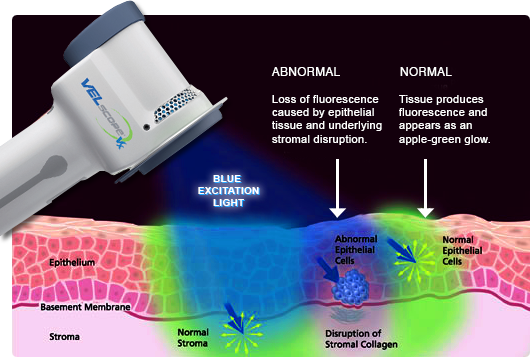
The VELscope® is an advanced oral assessment technology system that offers clinicians the ability to visualize oral tissue abnormalities that may indicate the presence of oral cancer or pre-malignant dysplasia. A VELscope® evaluation is quick, painless, and can be easily incorporated into an oral cancer screening visit.
The VELscope® is a handheld scope that utilizes an imaging modality that is sensitive to changes in the natural tissue fluorescence of the oral mucosa. The bright blue light of the VELscope® can distinguish healthy soft tissue inside the mouth from soft tissue that has undergone pathological changes.
This ability to identify, evaluate and monitor abnormal soft tissue changes that might not be caught otherwise makes the VELscope® an excellent addition to a periodic head and neck exam.
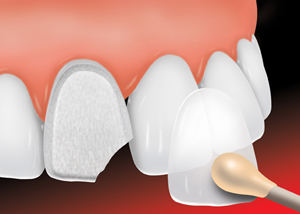
If your teeth suffer from gaps, chips, stains, or discolorations you may be a candidate for porcelain veneers, a highly effective and minimally invasive cosmetic procedure that can achieve beautiful results.
Porcelain veneers are thin facings custom-made of the highest quality ceramic materials that are designed to fit perfectly over the front of your teeth. One of the most conservative cosmetic treatments available, veneers can mask a host of dental imperfections to give you the smile that you have always wanted. Porcelain veneers not only enhance and improve the shape of your teeth, they are able to create an overall whiter and brighter smile.
One of the most appealing aspects of the process of fabricating porcelain veneers is that they involve minimal tooth preparation and take just a few visits. Porcelain veneers, once they are fabricated and fitted, are permanently bonded to the underlying teeth. The result is a naturally pleasing smile that is both strong and durable.

